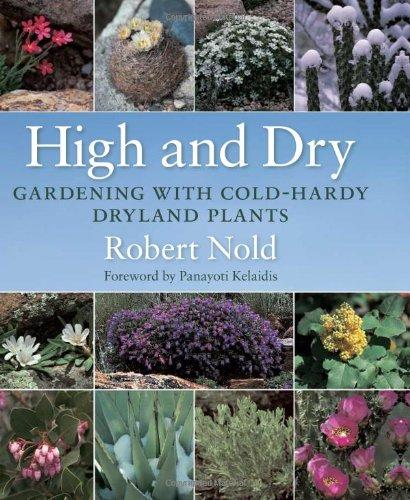High and Dry: Gardening with Cold-Hardy Dryland Plants by Robert Nold
Portland OR: Timber Press, 2008. 420 pp. Available from many online sources in hardcover and paperback.
Lately I’ve been spending a lot of time thinking about gardens and gardening. This is not a new occupation—and icertainly not so for the authors of my favorite gardening books. Bob Nold is a thinking gardener and his book, High and Dry: Gardening with Cold-Hardy Dryland Plants has much to recommend .
It has been ten years since Timber Press published the award-winning (he’d hate that) author’s High and Dry, but its luster has not diminished. Though expressly aimed at the Rocky Mountain/Intermountain West region, you’d be missing out if you take a pass. Like the Fosters in the northeast, Barr in the Plains, and others who’ve written about plants and gardening in specific parts of the world, the buffet has been set and what you eat is a matter of what you put on your plate.
Nold’s gardening philosophy…and contrarianism…is laid out early on and provides a unique insight into the man. He is unapologetic about writing for his conditions and his experience. It proves irresistible and useful.
Dispensing with many horticultural preconceptions and rules, Nold encourages readers to forget what they think they know, usually something remembered from an article in a magazine whose title escapes them or that book now residing in a box somewhere, and just get out and do it. Employing a no-nonsense approach to the entire enterprise, he relegates many bromides to the mental compost heap-in the first 60 pages. It’s a thesis that ranks up there with the introductory essay in Peter Del Tredici’s Wild Urban Plants of the Northeast, another region-specific book. Both are thought-provoking, challenge established wisdom, and provide grist for chapter meeting chats. Nold’s discussions of irrigation, soil and the like are a fine caveat emptor for any gardener, regardless of location. Just employ the same thought process for your patch of ground. Rock garden design and plant choice are not excepted and a thoughtful reader has much to gain.
The best part of the book is that it all comes from personal experience. Nold’s successes and failures infuse the book with personality and, dare it be said, curmudgeonly charm. “…Taking chances is part of the gardening experience,” he writes, “and so is death.” He has little time for those who have a ‘…tendency to collect names as much as plants.” On the perennial battle that is taxonomy: “The botanical names (i.e., the nomenclature) used in this book are the ones I feel like using.” He doesn’t spare his opinions about plants either. To wit: “Erigeron flagellaris (whiplash daisy) is a short-lived perennial; it’s a pity it lives at all.”
As Nold proclaims, the book is as much about him as it is about gardening. He writes about what HE knows, what HE thinks, what HE feels. His personality shines through and reading this book is the closest you’ll get to sitting down with him in his garden without hopping a plane.
His advice comes from years of gardening with a wide ranging of plants—not extrapolating climatic data from the home range of each of his prizes. He provides no silver bullets. The most generally applicable Nold-ism? “…the less cold-hardy a plant is, especially in spring, the less drought-tolerant it will be.” Nor does he hew to the accepted wisdom of the marketing mavens of the horticultural world. What you get is pure Bob.
Nold’s book is no mere catalog of plants, and if it were it would still be a useful addition to your library. It includes many plants that are unfamiliar—even to seasoned rock gardeners. They are thoughtfully divided into separate sections, rather than strictly alphabetically. The categories are: perennials and annuals, grasses, bulbs, rock garden plants, cacti, yuccas, etc., shrubs and trees, which make it easy to scan Nold’s choices for what to feature in a dryland garden. The list, in fact, is one of the best reasons to add the book to your collection because, as Nold states, “…horticulture has always fixed its eyes eastward in the search for desirable garden plants.” Here you are guaranteed to find plants, and even entire genera, that you’re unfamiliar with and that are worth a go in the dryland garden.
Great photographs and beautiful illustrations by Nold’s late wife, Cindy Nelson-Nold, add richness to the educational and entertaining prose, making for a total package that is on its way to being a classic of the genre. My biggest concern for this fine book: that people will avoid it because of its title or its geographic niche. It would be their loss. Reading High and Dry will not leave you that way.
Carlo Balistrieri is the executive director of Moore Farms Botanical Garden in Lake City, SC and a member of the Piedmont Chapter.

